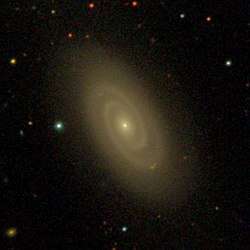NGC 4305
NGC 4305 is a dwarf spiral galaxy[2] located about 100 million light-years away[3] in the constellation Virgo. The galaxy was discovered by astronomer John Herschel on May 2, 1829.[4]
| NGC 4305 | |
|---|---|
 SDSS image of NGC 4305. | |
| Observation data (J2000 epoch) | |
| Constellation | Virgo |
| Right ascension | 12h 22m 03.6s[1] |
| Declination | 12° 44′ 27″[1] |
| Redshift | 0.006298[1] |
| Helio radial velocity | 1888 km/s[1] |
| Distance | 98 Mly (30 Mpc)[1] |
| Apparent magnitude (V) | 13.4[1] |
| Characteristics | |
| Type | SA(r)a[1] |
| Size | ~32,000 ly (9.7 kpc) (estimated)[1] |
| Apparent size (V) | 2.07 x 0.97[1] |
| Other designations | |
| UGC 07432, VCC 0522, PGC 040030, MCG +02-32-013[1] | |
Physical characteristics
NGC 4305 exhibits well-defined, smooth spiral arms which terminate well outside its central bulge.[6] This spiral structure appears to have been induced by a tidal interaction with NGC 4306.[7][8] Such a tidal interaction would also explain its deficiency in neutral hydrogen gas (HI).[5]
Virgo Cluster membership
Although considered to be a member of the Virgo Cluster,[2][9] its high radial velocity and blue luminosity suggest it is in fact a background galaxy.[5]
gollark: We're just executing phases.
gollark: I already wrote mine, so meh.
gollark: Oh, that was a decoy phase.
gollark: Phase 2201 completed successfully, unlike some OTHER phases.
gollark: j (integer)
See also
References
- "NASA/IPAC Extragalactic Database". Results for NGC 4305. Retrieved 2019-08-01.
- Davidge, T. J. (2018-10-31). "The Stellar Contents of Intermediate Mass Disk Galaxies in the Virgo Cluster. I. GMOS Spectra". The Astronomical Journal. 156 (5): 233. arXiv:1811.00041. Bibcode:2018AJ....156..233D. doi:10.3847/1538-3881/aae5fa.
- "Your NED Search Results". ned.ipac.caltech.edu. Retrieved 2019-08-02.
- "New General Catalog Objects: NGC 4300 - 4349". cseligman.com. Retrieved 2019-08-02.
- Sanchis, T.; Mamon, G. A.; Salvador-Sol´e, E.; Solanes, J. M. (2004-05-01). "The origin of H I-deficiency in galaxies on the outskirts of the Virgo cluster. II. Companions and uncertainties in distances and deficiencies". Astronomy and Astrophysics. 418: 393–411. arXiv:astro-ph/0401367. Bibcode:2004A&A...418..393S. doi:10.1051/0004-6361:20034158. ISSN 0004-6361.
- "NGC 4305 - SA(s)a". The De Vaucouleurs Atlas of Galaxies. Retrieved 2019-08-09.
- van den Bergh, Sidney; Pierce, Michael J.; Tully, R. Brent (1990-08-01). "Classification of galaxies on CCD frames". The Astrophysical Journal. 359: 4–14. Bibcode:1990ApJ...359....4V. doi:10.1086/169027. ISSN 0004-637X.
- Malin, D. (1994). "Interacting Galaxies in the Virgo Cluster". Astronomy from Wide-Field Imaging. 161: 567–576. Bibcode:1994IAUS..161..567M. doi:10.1007/978-94-011-1146-1_119. ISBN 978-0-7923-2879-7.
- Binggeli, B.; Sandage, A.; Tammann, G. A. (1985-09-01). "Studies of the Virgo Cluster. II - A catalog of 2096 galaxies in the Virgo Cluster area". The Astronomical Journal. 90: 1681–1759. Bibcode:1985AJ.....90.1681B. doi:10.1086/113874. ISSN 0004-6256.
External links
| Wikimedia Commons has media related to NGC 4305. |
- NGC 4305 on WikiSky: DSS2, SDSS, GALEX, IRAS, Hydrogen α, X-Ray, Astrophoto, Sky Map, Articles and images
This article is issued from Wikipedia. The text is licensed under Creative Commons - Attribution - Sharealike. Additional terms may apply for the media files.